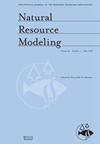Fisheries management and tipping points: Seeking optimal management of Eastern Baltic cod under conditions of uncertainty about the future productivity regime
IF 2.1
4区 环境科学与生态学
Q3 ENVIRONMENTAL SCIENCES
引用次数: 4
Abstract
Historical patterns of the Eastern Baltic cod stock recruitment show a shift from a regime with high reproductive potential before the early 1980s to a regime with low reproductive potential since then. This shift can be attributed to increasingly unfavorable environmental conditions for cod reproduction at that time: critical salinity and oxygen levels, needed for successful egg and larval development, deteriorated. Yet, significant inflows of salt‐ and oxygen‐rich water from the North Sea or improved eutrophication management might trigger a shift back to a more productive regime. Coupling a statistical recruitment model to a state‐of‐the‐art, age‐structured bio‐economic model of the Eastern Baltic cod fishery, we study how optimal management depends on the uncertainty about the future productivity regime. We extend the predominantly theoretical literature on optimal management of a natural resource with a potential regime shift by analyzing an empirical model of age‐structured population dynamics and by allowing for the possibility of a back‐shift from a “bad” into a “good” regime. We find that with a higher probability of a shift back to the more productive regime the optimal management of the fishery becomes more conservative in the short run. We conclude that these benefits for the fishery warrant strong action reducing eutrophication to increase the probability of a regime shift back to high reproductive potential of the Eastern Baltic cod fishery.渔业管理和临界点:在未来生产力制度不确定的条件下寻求东波罗的海鳕鱼的最佳管理
东波罗的海鳕鱼种群招募的历史模式表明,从20世纪80年代初之前繁殖潜力高的制度转变为此后繁殖潜力低的制度。这种转变可归因于当时对鳕鱼繁殖越来越不利的环境条件:卵和幼虫成功发育所需的临界盐度和氧气水平恶化。然而,北海富盐和富氧水的大量流入或富营养化管理的改善可能会引发向更高产的模式的转变。将统计招募模型与波罗的海东部鳕鱼渔业的最先进、年龄结构的生物经济模型相结合,我们研究了最佳管理如何取决于未来生产力制度的不确定性。我们通过分析年龄结构人口动态的经验模型,并考虑到从“坏”制度向“好”制度倒退的可能性,扩展了关于潜在制度转变的自然资源优化管理的主要理论文献。我们发现,从短期来看,回归生产力更高的制度的可能性越高,渔业的最佳管理就越保守。我们得出的结论是,这些对渔业的好处需要采取强有力的行动来减少富营养化,以增加东波罗的海鳕鱼渔业恢复高繁殖潜力的可能性。
本文章由计算机程序翻译,如有差异,请以英文原文为准。
求助全文
约1分钟内获得全文
求助全文
来源期刊

Natural Resource Modeling
环境科学-环境科学
CiteScore
3.50
自引率
6.20%
发文量
28
审稿时长
>36 weeks
期刊介绍:
Natural Resource Modeling is an international journal devoted to mathematical modeling of natural resource systems. It reflects the conceptual and methodological core that is common to model building throughout disciplines including such fields as forestry, fisheries, economics and ecology. This core draws upon the analytical and methodological apparatus of mathematics, statistics, and scientific computing.
 求助内容:
求助内容: 应助结果提醒方式:
应助结果提醒方式:


